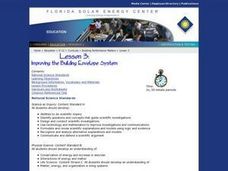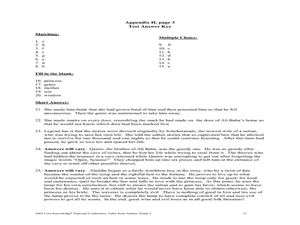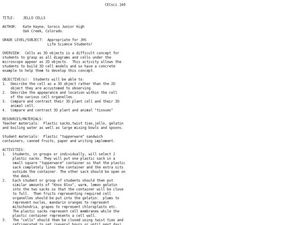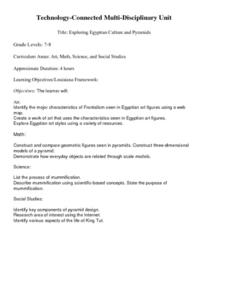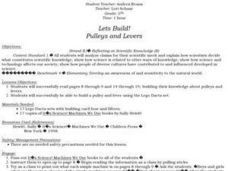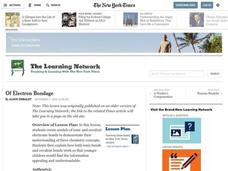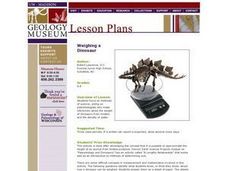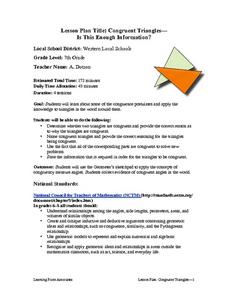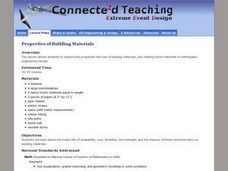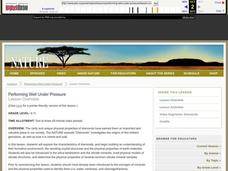Curated OER
Improving the Building Envelope System
Students explain the different heat transfer mechanisms and how they influence the building envelope. They develop ways in which the building envelope can be improved and test hypotheses about building envelope designs.
Curated OER
School Lighting Audit Preparation
Students work together to develop a school lighting audit plan. They practice using new vocabulary related to an energy audit. They also identify the components of a school lighting audit.
Curated OER
Paper Towers
Young scholars have the opportunity to use model-building as a way to help comprehend the forces and phenomena at work in the world around them. They describe gravity as a universal force that pulls everything toward the center of the...
Curated OER
Tales from Arabia
Third graders explore and develop interest in reading of foreign lands through the reading of The Arabian Nights and a variety of Cinderella stories. Students participate in a variety of folk literature activities. Students recognize the...
Ohio Department of Education
Actions with Fractions: Adding and Subtracting Fractions with Common Denominators
Fourth graders develop a conceptual understanding of fractions and begin to add and subtract fractions with like denominators. Included is a worksheet to assess readiness and a teacher's checklist showing class understanding at a...
Curated OER
Deep Thoughts
Students examine what lies within the Earth. They research and create scale models illustrating the layers of the Earth and write skits advocating a travel plan to send a probe into the Earth's mantle.
Curated OER
Introduction to Severe Weather Patterns
Students review basic weather concepts and terminology, and explore weather modeling tools.
Curated OER
Cosmic Wheels
Students build a scale model of the Solar System and determine the time other planets take to travel around the Sun in comparison to the time of the Earth's revolution. The velocity of the planets are also determined in this lesson plan.
Curated OER
Jello Cells
Middle schoolers create a three dimensional model of a cell. In this cellular structure lesson, students use gelatin, plastic bags, plastic containers, and fruit to construct a model of a cell. They compare the cells structures and stack...
Curated OER
Exploring Egyptian Culture and Pyramids
Students access a variety of Egyptian Culture and pyramid related resources on the Internet. They explore various websites, read articles, create an Egyptian art figure, construct a model of a pyramid, and describe the mummification...
Curated OER
Seasons
Young scholars investigate the reason for seasons on Earth during three activities. They construct a model of the Earth and Sun to identify patterns in the changes of the angle of light on the Earth's surface. Then they conduct a heat...
Curated OER
Sieve of Eratosthenes
Learners discover the Sieve of Erathosthenes. They explore a method to find all the prime numbers in a group of numbers. Using models, students practice divisibility rules while examining the difference between prime and composite numbers.
Curated OER
Pulleys and Levers
Fifth graders explore the concept of pulleys and levers. They read and discuss text from the book "It's Science! Machines We Use," and in small groups construct a simple lever and pulley using a Lego Dacta set.
Curated OER
Of Electron Bondage
Students create models of ionic and covalent electronic bonds to demonstrate their understanding of these chemistry concepts. They explain how both ionic bonds and covalent bonds work so that younger students can understand.
Curated OER
Weighing a Dinosaur
Learners role play as paleontologists who make inferences about the weight of dinosaurs. They use models and the density of water to make these inferences.
Curated OER
Congruent Trianges - Is This Enough Information?
Seventh graders determine whether two triangles are congruent and provide an explanation to why they are not. They apply concepts of measurement of angles and collect evidence of congruent angles in the world.
Curated OER
Teaching Radioactive Decay: Radioactive Half-life And Dating Techniques
High schoolers generate a radioactive decay table for an imaginary element using a box filled with pinto beans and M&M's. They use their data to plot a decay graph, develop the concept of half-life, and use the graph to "age" several...
Curated OER
The Sun and Moon
Students understand basic concepts about Earth, the Sun and the Moon,
such as relative movement and the phases of the moon. Through discussion, looking at pictures, listening to Native American stories, observing, and building models,...
Curated OER
Layers of the Earth: Plate Tectonics
Sixth graders participate in a instructional activity that is about investigating the different layers of the earth and defining how the plates move over the mantle. They engage in a variety of activities and use mathematics to create...
Curated OER
Properties Of Building Materials
Students investigate the concept of building materials and how they are used to create different things. They focus upon the availability, cost, flexibility, and strength of different building materials. This is done by taking part in a...
Curated OER
Principles of Flight: Where are We?
Students explore the concept of topographical maps. In this topographical map lesson, students discuss how airplanes know where to fly. Students use topographical maps to simulate a field trip on the computer.
Curated OER
Performing Well Under Pressure
Students study the physical properties of minerals and illustrate their functions. In this mineral lesson students construct models of some minerals.
Curated OER
Cooler in the Shadows
Students explore Earth science by creating a scale model in class. In this shadow lesson plan, students research the impact the sun has on Earth shadows and complete a space science worksheet. Students create models of the Sun and Earth...
Institute of Electrical and Electronics Engineers
Design and Build A Better Candy Bag
Young scholars discuss how the final design for a product can affect its success. They work together to design and develop a better candy bad. They predict the volume and strength they need for the bag to be successful.
